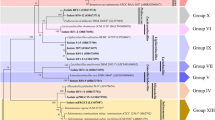Abstract
Bacteria were isolated from rabbit faeces using equine caecal fluid as a growth medium. Two new isolates of the genus Streptococcus are described in terms of their biochemical properties. One of these has a 16S rRNA gene with 97.7%, and the other 98.5%, identity to Streptococcus thoraltensis. While S. thoraltensis has been described in the intestinal tract of pigs, it is generally considered to inhabit the porcine genital tract. The biochemical properties of these bacteria indicate that both new isolates showed an ability to digest xylose, an adaptation beneficial for survival in a niche where much of the nutrient supply is of plant origin. Moreover, having bacteria able to digest xylose in the digestive tract should be beneficial to the rabbit, allowing more effective utilisation and digestion of food. This work provides one of the few examples of an analysis of the physiological properties of a bacterium found in the hindgut of the rabbit. By building up a number of such studies, the mechanisms of bacterial digestion in the rabbit will become better understood.

Similar content being viewed by others
References
Abecia L, Fondevila M, Balcells J et al (2005) Molecular profiling of bacterial species in the rabbit caecum. FEMS Microbiol Lett 244:111–115
Altschul SF, Gish W, Myers EW, Lipman DJ (1990) Basic local alignment search tool. J Mol Biol 215:403–410
Belenguer A, Fondevila M, Balcells J et al (2008) In vivo and in vitro study of caecal fermentation pattern and methanogenesis in rabbits. In: Proceedings of 9th World Rabbit Congress, Verona, Italy, pp 535–540
Bergey DH, Holt JG (1994) Bergey’s manual of determinative bacteriology, 9th edn. Lippincott Williams & Wilkins, Philadelphia
Devriese LA, Pot B, Vandamme P et al (1997) Streptococcus hyovaginalis sp. nov. and Streptococcus thoraltensis sp. nov., from the genital tract of sows. Int J Syst Bacteriol 47:1073–1077
Felsenstein J (1989) PHYLIP—phylogeny inference package (Version 3.2). Cladistics 5:164–166
Halsall DM, Turner GL, Gibson AH (1985) Straw and xylan utilisation by pure cultures of nitrogen-fixing Azospirillum spp. Appl Environ Microbiol 49:423–428
Heald PJ (1952) The fermentation of xylans in the rumen of the sheep. Br J Nutr 7:124–130
Hongoh Y, Deevong P, Inoue T et al (2005) Intra- and interspecific comparisons of bacterial diversity and community structure support coevolution of gut microbiota and termite host. Appl Environ Microbiol 71:6590–6599
Milinovich GJ, Trott DJ, Burrell PC et al (2007) Fluorescence in situ hybridization analysis of hindgut bacteria associated with the development of equine laminitis. Environ Microbiol 9:2090–2100
Monteils V, Cauquil L, Combes A et al (2008) Potential core species and satellite species in the bacterial community with the rabbit caecum. FEMS Microbiol Ecol 66:620–629
Olsen MA (1994) Digestion of herring by indigenous bacteria in the minke whale forestomach. Appl Environ Microbiol 60:4445–4455
Page RDM (1996) TREEVIEW: an application to display phylogenetic tress on personal computers. Comput Appl Biosci 12:357–358
Skinner FA, Quesnel LB (1987) Streptococci. Academic Press, London
Smith HW (1965) Observations on the flora of the alimentary tract of animals and factors affecting its composition. J Pathol Bacteriol 82:72–79
Thompson JD, Higgins DG, Gibson TJ (1994) CLUSTAL W: improving the sensitivity of progressive multiple sequence alignment through sequence weighting, position-specific gap penalties and weight matrix choice. Nucleic Acids Res 22:4673–4680
Zomborszky-Kovacs M, Gyarmati T, Parizs T et al (2000) Some physiological properties of the digestive tract in traditionally reared and exclusively milk-fed young rabbits. In: Proceedings of 7th World Rabbit Congress, Valencia, Spain, pp 483–490
Author information
Authors and Affiliations
Corresponding author
Rights and permissions
About this article
Cite this article
Borø, S., McCartney, C.A., Snelling, T.J. et al. Isolation of Streptococcus thoraltensis from Rabbit Faeces. Curr Microbiol 61, 357–360 (2010). https://doi.org/10.1007/s00284-010-9619-0
Received:
Accepted:
Published:
Issue Date:
DOI: https://doi.org/10.1007/s00284-010-9619-0




